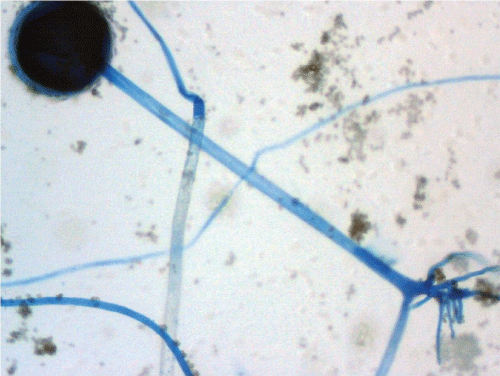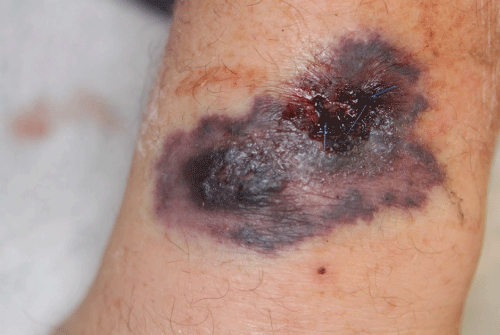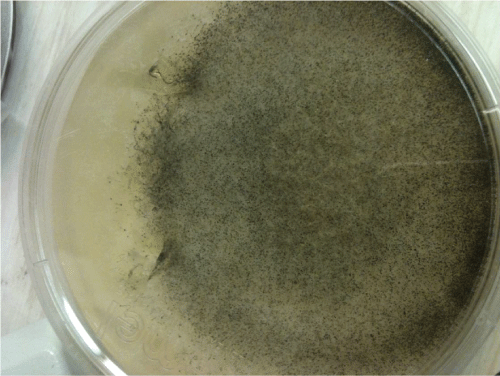Journal of Dermatology Research and Therapy
Explosive Cutaneous Mucormycosis Requiring Limb Amputation: Case Report and Literature Review
Vikas Patel1*, Stephen Squires1, Tarek Shaath2, Daniel R Hinthorn3, Garth R Fraga4 and Rebecca Horvat4
1Department of Dermatology, University of Kansas Medical Center, USA
2Massachusetts General Hospital, USA
3Department of Infectious Diseases, University of Kansas Medical Center, USA
4Department of Pathology and Laboratory Medicine, University of Kansas Medical Center, USA
*Corresponding author:
Vikas Patel, Department of Dermatology, University of Kansas Medical Center, 3901 Rainbow Blvd, Kansas City, KS 66160, USA, Tel: (217) 799-4384, E-mail: vpatel5@kumc.edu
J Dermatol Res Ther, JDRT-1-005, (Volume 1, Issue 1), Case Report; ISSN: 2469-5750
Received: May 20, 2015 | Accepted: August 18, 2015 | Published: August 20, 2015
Citation: Patel V, Squires S, Shaath T, Hinthorn DR, Fraga GR, et al. (2015) Explosive Cutaneous Mucormycosis Requiring Limb Amputation: Case Report and Literature Review. J Dermatol Res Ther 1:005. 10.23937/2469-5750/1510005
Copyright: © 2015 Patel V, et al. This is an open-access article distributed under the terms of the Creative Commons Attribution License, which permits unrestricted use, distribution, and reproduction in any medium, provided the original author and source are credited.
Summary
Mucormycosis is a potentially fatal systemic fungal infection. Risk factors include immunosuppression, organ transplantation, and diabetes mellitus. Rhinocerebral mucormycosis is the most common presentation in diabetic patients, whereas pulmonary mucormycosis is the most common presentation in patients with hematologic neoplasms. We describe an immunocompromised leukemia patient with painful ecchymotic plaques on the forearm. Punch biopsy demonstrated angioinvasive mucormycosis and culture grew Rhizopus species. In spite of immediate Amphotericin B therapy, amputation was necessary to halt progression of the disease. Early diagnosis and aggressive therapy of mucormycosis in immunocompromised patients is essential. Rhizopus species are the leading cause of mucormycosis. Infection begins through inhalation or ingestion of infectious conidia. Germination into hyphae subsequently occurs within tissues, leading to invasion of vasculature causing thrombosis and infarction. Liposomal Amphotericin B is the best treatment as it delivers the highest concentration of drug with the least risk of nephrotoxicity. Additionally, neutropenia and phagocytic dysfunction should be corrected, as these deficits are a more significant prognostic factor than the extent of mucormycosis. Cutaneous infection is treated with additional extensive surgical debridement. Medical and surgical treatment work synergistically to provide the lowest mortality rates. This case highlights the importance of heightened scrutiny of skin findings in immunocompromised individuals along with the significance of punch biopsy to establish an early diagnosis. Relying on cultures for diagnosis may delay therapy and result in catastrophic outcomes.
Keywords
Mucormycosis, Rhizopus, Fungus, Infection, Immunocompromised, Diabetes, Leukemia, Amputation
Introduction
Mucormycosis is a rare, potentially fatal systemic fungal infection. It can produce catastrophic outcomes in immunocompromised patients. Early diagnosis is essential to minimize morbidity and mortality. Treatment is challenging and usually entails Amphotericin B and surgical debridement [1,2]. Recent reports have suggested a shift in incidence of predisposing conditions and primary presentations of mucormycosis. In 2005, major underlying conditions included diabetes mellitus (36%) and hematologic malignancies (17%); most common presentations were rhinocerebral (39%), pulmonary (24%), and cutaneous infection (19%) [2]. In 2011, the major underlying conditions shifted to include hematologic malignancies (44%), trauma (15%), and hematopoietic stem cell transplantation (9%), while diabetes (9%) declined as a predisposing illness; most common presentations were pulmonary (30%), rhinocerebral (27%), soft tissue (26%), and disseminated (15%) infections [1]. The evolving zygomycotic presentations reflect change in the nature of underlying disease, as rhinocerebral mucormycosis is most common in diabetic patients whereas pulmonary mucormycosis is most common in patients with hematologic neoplasms. The swing in epidemiology is hypothesized to be due to increased immunosuppression and increased physician awareness of patient risk [1].
Case Report
A thirty-nine-year-old home-less Caucasian male with diabetes mellitus type I, hypertension, hyperlipidemia, history of myocardial infarction, chronic myelogenous leukemia (CML), and recurrent methicillin sensitive S. aureus (MSSA) right arm cellulitis presented to a local community hospital with fatigue and uncontrolled epistaxis. The patient also noticed two erythematous pea-sized macules on the dorsum of his left wrist of unknown origin or etiology. Complete blood count revealed pancytopenia. Bone marrow biopsy demonstrated blastic transformation from CML to Acute B-cell Lymphocytic Leukemia with 92% blasts. He was diagnosed with blast phase CML and transferred to our institution for the first arm of HyperCVAD therapy (cyclophosphamide, vincristine, doxorubicin, and dexamethasone). Exact duration of previous treatments were unknown as patient was a poor historian and unable to clarify where previous care.
Physical examination revealed two tender, ecchymotic plaques with distinct violaceous borders on the dorsal left wrist. Lesions were localized to sites of prior tape placement used for IV line stabilization, indicating the lesions may have been precipitated by IV puncture. Within thirty-six hours, the plaques coalesced into hemorrhagic eschars with indistinct borders, violaceous halos, and central vesiculation (Figure 1).
Dermatology was consulted. On examination, both eschars were excruciatingly tender to palpation with tenderness extending at least two centimeters beyond visible eschar borders. Severe pain prevented the patient from moving his left hand and fingers. Within a day, the dorsal and much of the volar surfaces of the left forearm became erythematous, edematous, and extremely tender to light touch. CT of the head, maxillofacial sinuses, chest, and abdomen was negative for involvement. MRI of the left upper extremity revealed extensive cellulitis and myositis of the forearm. Punch biopsies were obtained for routine histopathology and tissue culture. Histopathology revealed deep fungal infection compatible with angioinvasive mucormycosis. Culture plates grew Rhizopusspp. The patient was started on Amphotericin B and the orthopedic service was consulted. Debridement of necrotic tissue was attempted with the goal of limb preservation. However, surgical exploration demonstrated the entire forearm to be necrotic, and an above elbow amputation was performed. No recurrent deep fungal infection was detected post-amputation. The patient eventually underwent a mismatched, unrelated stem cell transplant. Unfortunately, he succumbed to refractory hepatic graft-versus-host disease 203 days after amputation.
Discussion
Rhizopus species are the most common cause of mucormycosis; less common causative agents include Mucor species, Cunninghamellabertholletiae, Apophysomyceselegans, Absidia species, Saksenaea species, and Rhizomucorpusillus. Rhizopus species belong to the Zygomycetes class of fungi, ubiquitous in soil and decaying organic matter, and are typically minimally virulent. Carbohydrates such as fruits serve as substrates for growth [3]. Zygomycetes may cause life-threatening disseminated infections in immunosuppressed individuals. Incidence of mucormycosis is rising with the increased prevalence of immunosuppression and improved physician detection of invasive fungal infections [4-6]. Consequently the use of antifungal prophylaxis for invasive fungal infections is also increasing but varies widely amongst institutions [7]. Fluconazole was the first azole used for chemoprophylaxis followed by itraconazole. The newer azoles include voriconazole introduced in 2003 and posaconazole in 2007. Studies have failed to show benefits of using voriconazle compared to fluconazole and itraconazole for prophylaxis of invasive fungal infections. However posaconazole has been identified as the most efficaciousazole for antifungal prophylaxis [8].
Fungal agents from the Mucoraceae family grow well on common microbiologic media such as Sabouraud dextrose agar without cycloheximide. Cultures incubated at 37℃ typically yield molds detected within 24 to 48 hours of incubation. Fungal species are typically identified by both macroscopic features of colonies and microscopic growth characteristics. Rhizopus species produce rapid growth of white, cottony colonies and development of dark sporangiophores (Figure 2). Additionally, the genus forms distinct non-branching grouped sporangiophores with clear rhizoids (Figure 3.) Mucor and Absidia genera on the other hand, do not produce rhizoids, but like Rhizopus species, generally contain numerous branched sporangiophores.

.
Figure 3: Distinct sporangiophores with clear rhizoids (root-like structures), non-branching hyphae, and dark-staining spores (Lactophenol cotton blue, X400).
View Figure 3
The pathogenesis of zygomycosis begins with the inhalation, ingestion, or traumatic inoculation of infectious conidia into tissue [9]. After inoculation, germination into hyphae ensues. Hyphae then invade tissue and vasculature causing thrombosis and infarction [10]. Immunosuppressive medications, organ transplantation, and diabetes are the most prevalent risk factors for mucormycosis. Normally, macrophages phagocytose spores and neutrophils destroy hyphae by oxidative cytolysis [3]. Quantitative and qualitative deficiencies of phagocytic cells increase the risk of disseminated infection. Infections resulting from contaminated polyethylene tape have also been documented [11]. We suspect a similar cause in the present patient as his lesions originated locally in areas where tape was used to stabilize peripheral catheters.
Treatment of mucormycosis is multifaceted, entailing intravenous medication, immune system fortification, and surgery. Early administration of appropriate antifungal therapy is vital. Amphotericin B is the only antifungal agent effective against Zygomycetes [1,2]. Three formulations have been approved by the FDA. Liposomal Amphotericin B is utilized most often as it delivers the highest concentration of drug with the least risk of nephrotoxicity. Once antifungal therapy has been adminstered, neutropenia and phagocytic dysfunction should be corrected. In fact, control of this predisposing risk factor is a more significant prognosticator than the extent of mucormycosis [12]. Cutaneous infection is better treated with extensive surgical debridement in addition to systemic antifungal therapy [1,13]. Combined medical and surgical management has 24% mortality in contrast to 58% for medical management alone and 44% for surgical management alone [1].
Alternative treatment protocols are under investigation. Due to the slow pharmacokinetic profile of Amphotericin B, some clinicians prefer to delay surgical intervention in immunocompetent patients for ten days to allow the drug to reach effective tissue concentrations. The rationale of this approach minimizes amputation risk [14]. Other agents such astacrolimus and posaconazole are known to synergistically eradicate Rhizopusoryzae in experimental models. However, uncertainties regarding adverse effects in humans as well as efficacy against other members of Rhizopusremain to be elucidated [15].
Prompt intervention and aggressive treatment of cutaneous mucormycosis is vital in the immunocompromised patient population [1,2]. Our patient presented with two small nondescript macules that infiltrated the entire forearm within four days. Prompt diagnosis by punch biopsy was essential for early diagnosis and immediate intervention with systemic Amphotericin B. Amputation as an aggressive therapy that prevented further invasion and destruction. Treatment delay may have resulted in catastrophic widely disseminated disease. This case illustrates the importance of heightened scrutiny of skin findings in immunocompromised individuals along with the significance of punch biopsy to make an early diagnosis. Relying on cultures for diagnosis may delay therapy and result in morbid outcomes. Therapeutic options may be limited by rapid disease progression in the face of hematologic comorbidities. Since randomized controlled trials may be lacking considering the rarity of mucormycosis, the extremely aggressive nature of the disease in immunocompromised individuals mandates further study.
Acknowledgements
Patrick Prath, MD.
References
-
Skiada A, Pagano L, Groll A, Zimmerli S, Dupont B, et al. (2011) Zygomycosis in Europe: analysis of 230 cases accrued by the registry of the European Confederation of Medical Mycology (ECMM) Working Group on Zygomycosis between 2005 and 2007. Clin Microbiol Infect 17: 1859-1867.
-
Roden MM, Zaoutis TE, Buchanan WL, Knudsen TA, Sarkisova TA, et al. (2005) Epidemiology and outcome of zygomycosis: a review of 929 reported cases. Clin Infect Dis 41: 634-653.
-
Gonzalez CE, Rinaldi MG, Sugar AM (2002) Zygomycosis. Infect Dis Clin North Am 16: 895-914.
-
Ribeiro EF, dos Santos VM, Paixao GT, Cruz LR, Danilow MZ, et al. (2013) Mucormycosis in a patient with acute myeloid leukemia successfully treated with liposomal amphotericin B associated with deferasirox and hyperbaric oxygen. Mycopathologia 175: 295-300.
-
Schofield C, Stern A, Jevtic A (2013) Disseminated zygomycosis due to Mycocladus corymbifera with cutaneous and cerebral involvement. Australas J Dermatol 54: e8-11.
-
Sugui JA, Christensen JA, Bennett JE, Zelazny AM, Kwon-Chung KJ (2011) Hematogenously disseminated skin disease caused by Mucor velutinosus in a patient with acute myeloid leukemia. J Clin Microbiol 49: 2728-2732.
-
Pappas PG, Alexander BD, Andes DR, Hadley S, Kauffman CA, et al. (2010) Invasive fungal infections among organ transplant recipients: results of the Transplant-Associated Infection Surveillance Network (TRANSNET). Clin Infect Dis 50: 1101-1111.
-
Pagano L, Caira M (2014) The role of primary antifungal prophylaxis in patients with haematological malignancies. Clin Microbiol Infect 6: 19-26.
-
Kauffman CA (2006) Fungal infections. Proc Am Thorac Soc 3: 35-40.
-
Kwon-Chung KJ (2012) Taxonomy of fungi causing mucormycosis and entomophthoramycosis (zygomycosis) and nomenclature of the disease: molecular mycologic perspectives. Clin Infect Dis 1: S8-S15.
-
Lalayanni C, Baliakas P, Xochelli A, Apostolou C, Arabatzis M, et al. (2012) Outbreak of cutaneous zygomycosis associated with the use of adhesive tape in haematology patients. J Hosp Infect 81: 213-215.
-
Abu El-Naaj I, Leiser Y, Wolff A, Peled M (2013) The surgical management of rhinocerebral mucormycosis. J Craniomaxillofac Surg 41: 291-295.
-
Moran SL, Strickland J, Shin AY (2006) Upper-extremity mucormycosis infections in immunocompetent patients. J Hand Surg Am 31: 1201-1205.
-
Saraiya HA (2012) Successful management of cutaneous mucormycosis by delaying debridement. Ann Plast Surg 69: 301-306.
-
Lewis RE, Ben-Ami R, Best L, Albert N, Walsh TJ, et al. (2013) Tacrolimus enhances the potency of posaconazole against Rhizopus oryzae in vitro and in an experimental model of mucormycosis. J Infect Dis 207: 834-841.







